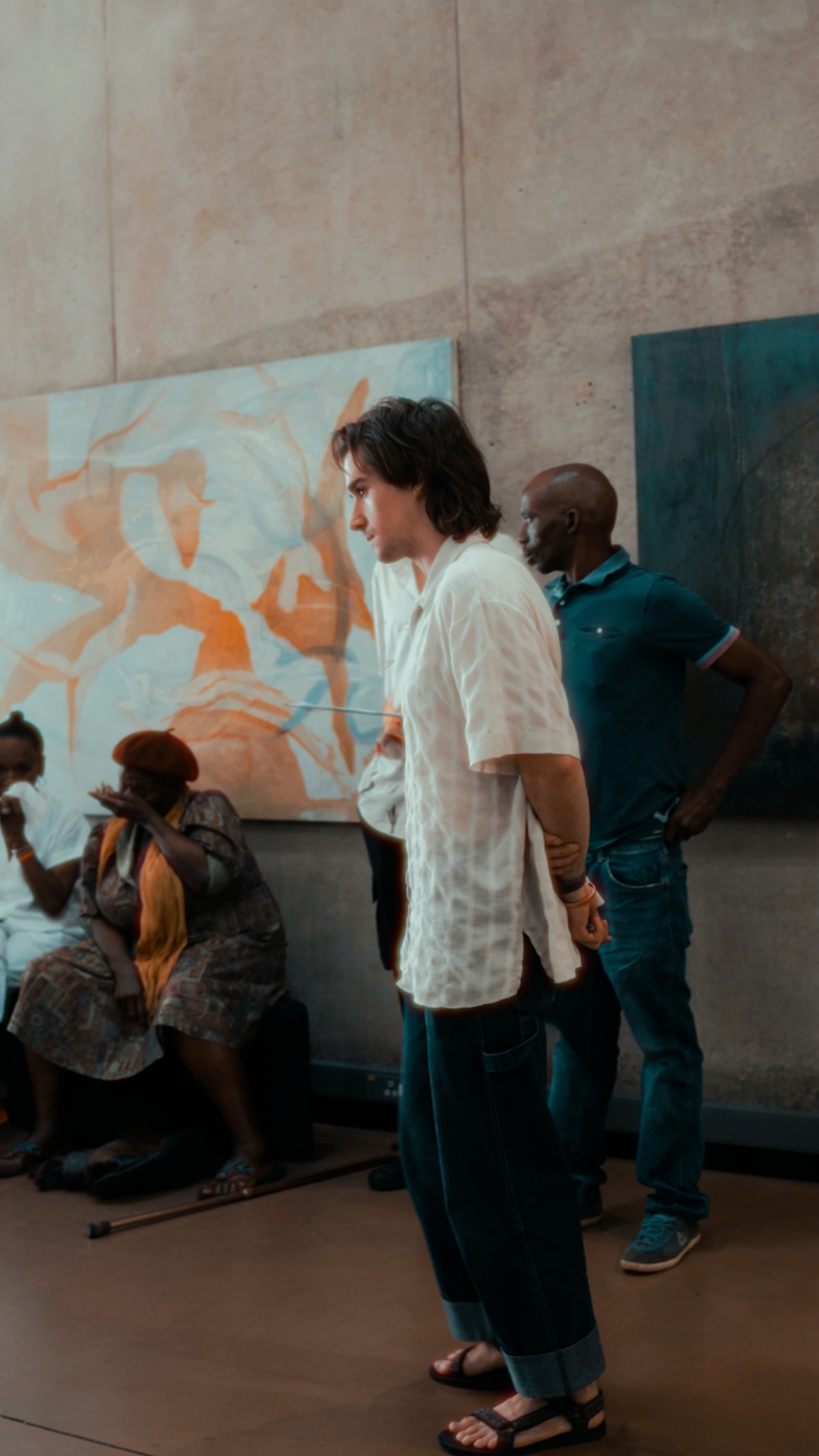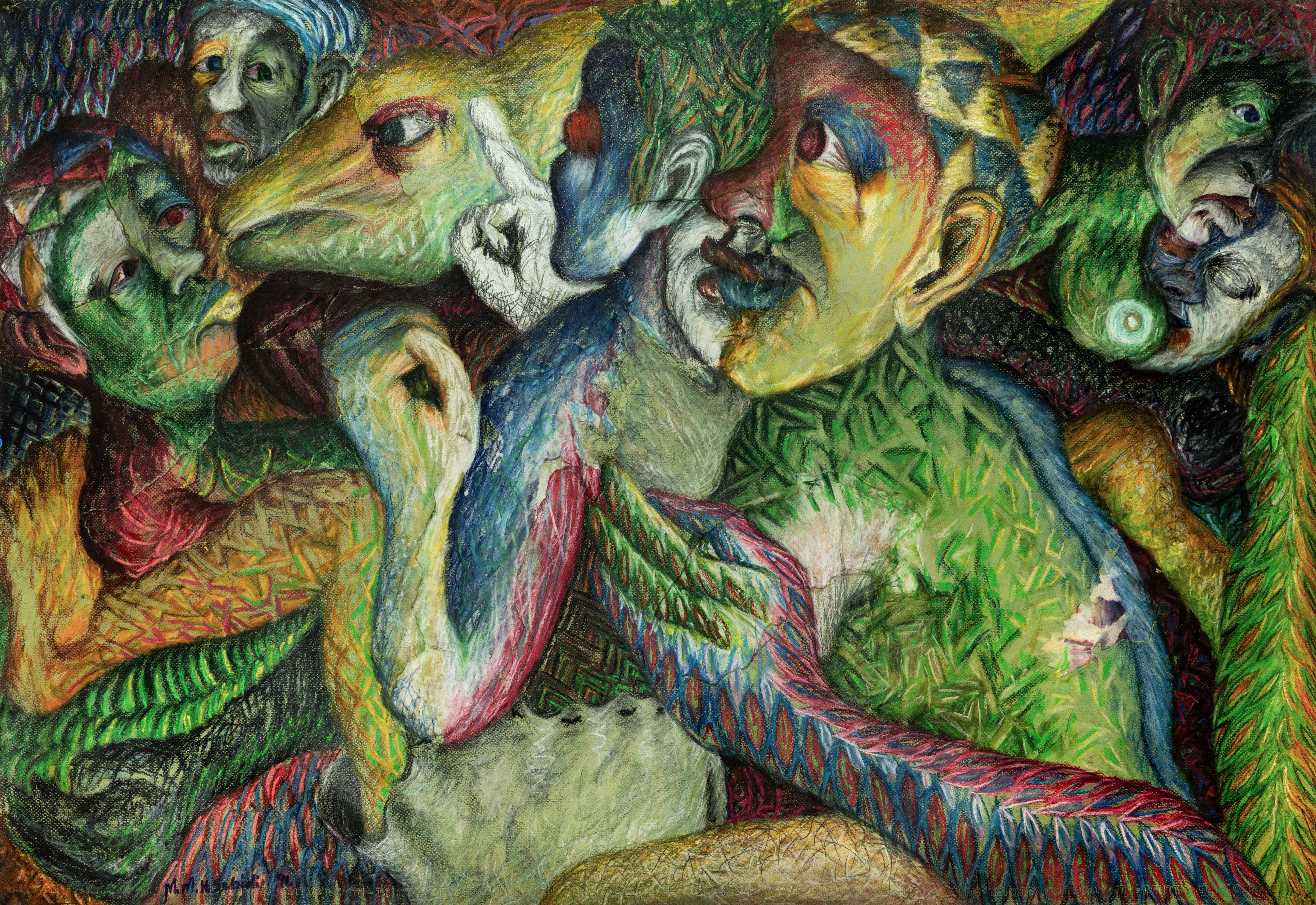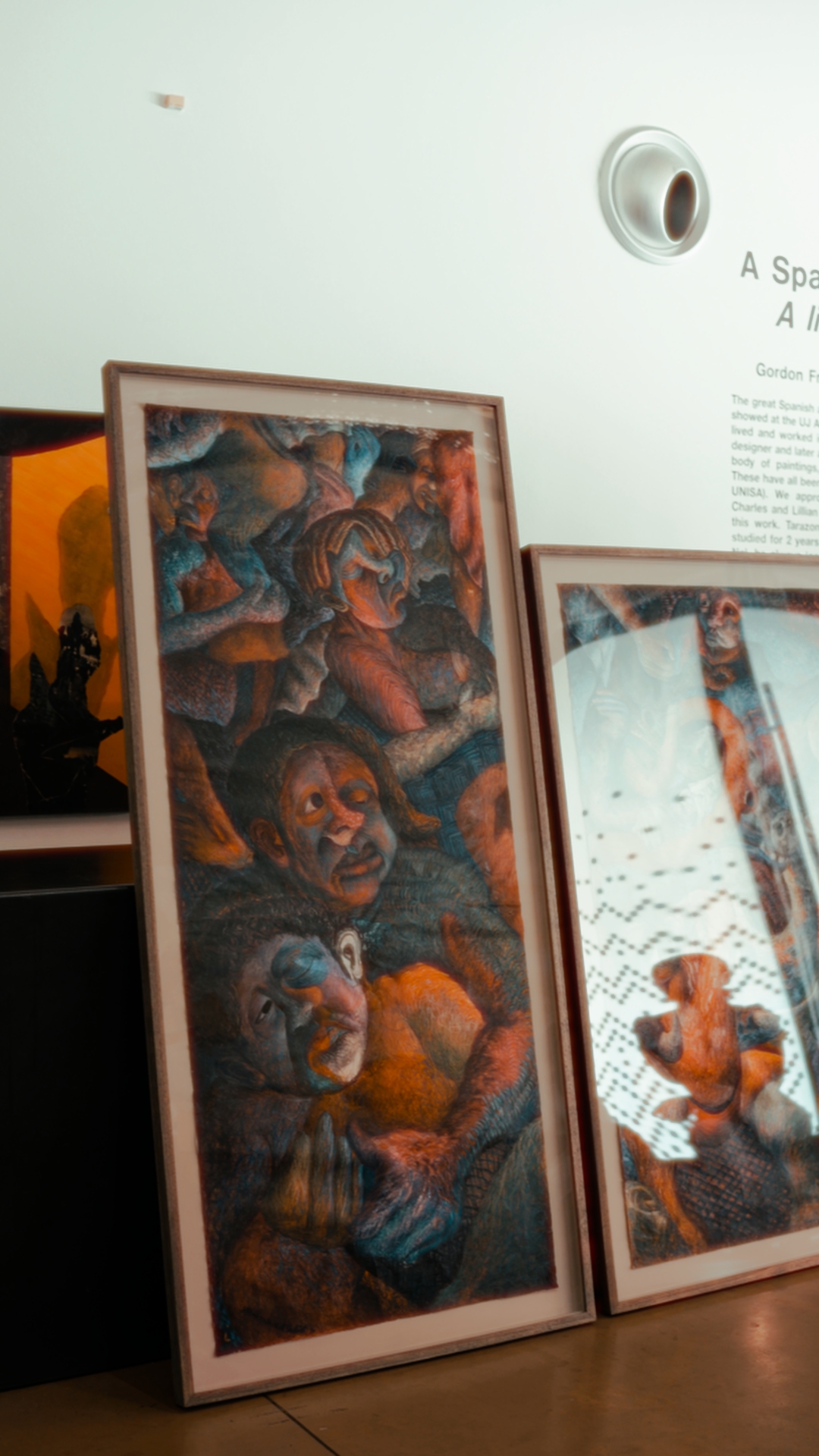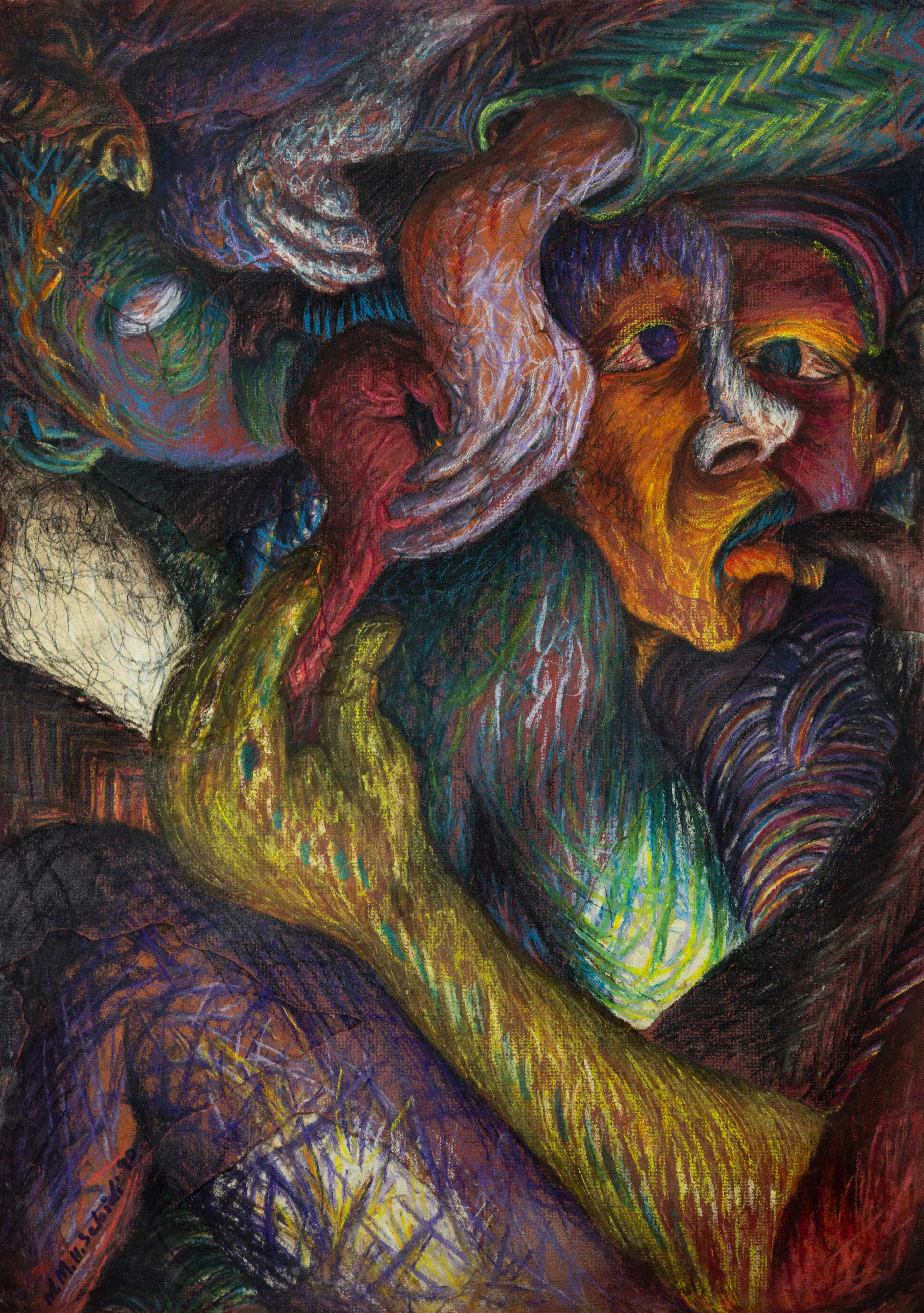Ntlo E Etsamayang (The Walking House), Mmakgabo Mmapula Helen Sebidi
- By Gabriel Baard

Mmakgabo Mmapula Helen Sebidi, Mafatsi A Tlhakana (The Meeting of Different Realms), (1991), Pastel on paper, 147 by 109 cm, Artists collection
There is an undeniable mystique and captivating allure surrounding Mmakgabo Sebidi's art – a depth that invites exploration, akin to the intricate layers of her own life story woven into each artwork. Mmakgabo stands as the bridge between many worlds, a vehicle for communication, a walking house. This house was built inside her by her matriarch grandmother, who would say:
"Do not be mistaken. The mud walls we are building are not the real house but merely shelter from the sun and the rain. It is you I am building into a walking house destined for where our sun sets and rises to houses that, like you, are built from hard labour. It is here you will knock on the door of each house and be received. Together, through sweat and blood, you will master every conceivable challenge."
Art has always been deeply rooted in Mmakgabo’s cultural heritage, reflecting a profound reverence for the values that have shaped her upbringing and worldview. Having become the first black recipient of the Standard Bank Young Artist prize (1989), Mmakgabo is representative of a turning point in national politics that was taking place in the 80s and 90s, a time when the days of apartheid were numbered. Within this transformative narrative, she emerged as a symbol of resilience and political awakening, capturing the essence of a nation in flux. Her work during this time, reifies the personal as political, and political as personal, unbounded from conventions of resistance or feminist art.
During many of our conversations, Mmakgabo has described how she would “move blindly in this world”, a process dedicated to research outside and distinct from the typical and concretised methodologies before her. It is instead, an unpredictable and fluid push and pull of possibilities and potentialities.

Gabriel Baard with Helen Sebidi, courtesy of University of Johannesburg
“I like moving blindly. It is like being given the words. Questioning them, that is research. But you won’t know how they build you. They will not make you open your mouth. They will let you move where you want to go. Knowing is the difficult part.” In this way, her enunciation of subjectivity reflects the conflicts taking place at this time in a way that no one else could, having been realised outside realms of consciousness while remaining deeply connected to land and people.
Read in the context of resistance or protest art, her work does not conform to this symptomatic art historical. Its language is its own, a conglomerate of witnessed, felt, and lived turmoil and trauma, pulsating with energy, and rejecting fixed definitions. Her full title, Mmakgabo Mmapula Mmankgato Helen Sebidi, carries the weight of her identity, having been named Mmapula, mother of rain, by her community, as a long drought ended following her birth. While Sebidi, meaning ‘boiling’ seems to overflow in an energetic pulse which runs through her core, often saying to me, “My work is never done. I am living for the children.”
Through her unique portrayal of the human form, Mmakgabo delves into the complexities of black identity and spirituality, offering a poignant reflection on the African experience. Yet, amidst political turmoil, she faced moral dilemmas, navigating the delicate balance between artistic expression and social responsibility. When she received an invitation to speak in the US, she grappled with the implications of violating the UN boycott of apartheid South Africa. Ultimately, she chose to follow her convictions, defying the naysayers and embarking on a journey that further solidified her reputation as a trailblazing artist.
 Mmakgabo Mmapula Helen Sebidi, Kamogelo ya Moya (Conversing with the spirits), (1991) Pastel on paper, 73 by 109cm, Artists collection
Mmakgabo Mmapula Helen Sebidi, Kamogelo ya Moya (Conversing with the spirits), (1991) Pastel on paper, 73 by 109cm, Artists collection
In 1991, Mmakgabo's journey took her to Sweden, where she hoped to share her vision with a new audience. However, what should have been a triumph turned into heartbreak when her works disappeared without a trace, leaving behind unanswered questions and unresolved grief. It is these very artworks which will be exhibited for the first time at the UJ gallery, having been recently discovered in the attic of a Folk High school where Mmakgabo was based during her stay in 1991.
Ntlo E Etsamayang, (The Walking House) serves as a celebration of Mmakgabo’s remarkable artistic journey and commitment to Indigenous Knowledge Systems, confronting themes of self-positioning, power, responsibility, and healing.
Marked by the recovery of 28 lost artworks following more than three decades of grief, this exhibition reflects on the exchange of knowledge between South Africa and Sweden, highlighting Sebidi's dedication to facilitating communication of the socio-political conditions that govern day-to-day existence.
The artworks in this exhibition not only reclaim lost masterpieces to the public eye but resurrect a critical chapter in the national artistic consciousness. Each work communicates an acute and unbounded search into the relationship between humanism and spiritualism of the contemporary black African lived experience. This exhibition showcases not only Mmakgabo’s early artistic endeavours but also a pivotal juncture in her practice, heralding a significant moment of stylistic transformation into a new idiom; part figuration, part abstraction, yet continuously seeking to escape the boundaries of both.

Helen Sebidi Exhibition at the University of Johannesburg
Mmakgabo turned 81 recently, having been born at the dawn of Bantu education. She stands today as a poignant metaphor for the collective struggle. Her art serves as a powerful reminder of heritage while simultaneously offering a visionary perspective for the future. Through her body of work, Mmakgabo nourishes the soul of the nation. Her work showcases a deep reverence for the values that have influenced her. Her art depicts the disordered and often uncomfortable process of decolonising, through which she has cultivated a visual language that compels us to feel things, to get our hands dirty.
As we stand on the doorstep of thirty years of democracy, many young voters feel this is their 1994. Urged to not only make a change but embody that change, and understanding the importance of these elections as a defining moment in South Africa’s history, I cannot help but see the synchronicities between these moments of change through the lens of Mmakgabo’s rediscovered art. In this context, Mmakgabo said something profound to me the other day. “I feel that they [her artworks] were hidden for this communication to be extended,” suggesting that if her works had been exhibited and returned to her in 1991, they would most certainly have been sold and the communication ended. This body of work, brought into the world just before the dawn of our democracy and returned 30 years later, is a portrait of humanity in a kaleidoscopic montage of political turmoil, and lost for three decades. It represents a moment of antipodal communication frozen in time that is perhaps more poignant today than ever.

Mmakgabo Mmapula Helen Sebidi, Are Faneng Bophelo (Exchange), (1990) Pastel on paper, 81,6 by 55,4cm, Artists collection
As we prepare to unveil Mmakgabo's lost masterpieces to the world, I am filled with awe and gratitude. It has been a journey of rediscovery – of art, resilience, and the enduring spirit of hope. She is more than an artist; she is a storyteller, a visionary, a beacon of hope. Through her art, she invites us on a journey of self-discovery and transformation, reminding us of the power of creativity to transcend boundaries and unite us in shared experiences of beauty and truth. In the enigmatic world of Mmakgabo Sebidi, we find solace, inspiration, and a profound connection to the human experience.
Further Reading In Articles
African Artist Directory















